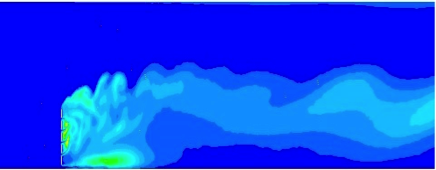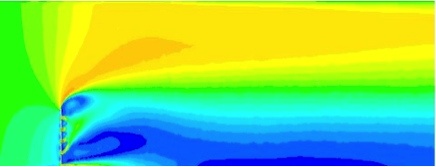Allah Rakha

First Impressions
Wind barrier modelling for highways
Wind barriers are artificial structures designed for wind protection. Their function is to reduce wind velocity within a certain distance. The numerical simulations were set to simulate the wind barrier. For this Computational Fluid Dynamics (CFD) simulation we applied cell-centered numerics, a segregated approach on a collocated, unstructured grid. The three-dimensional finite volume method was used for reynold average navier stokes equations (RANS) equation discretization. This computational study of fluid turbulence of wind barriers was done by using well-known CFD models.
For this study two turbulence models were used, realizable (RKE) and Re-Normalization Group (RNG) KE model. High performance computing (HPC) was utilized for numerical simulations. The computer code was parallelized applying the message passing interface (MPI) technique for communication between processes. Each numerical simulation was solved on 60 processor cores for a total duration of 96 hours.
The snapshots of the velocity of streamline and the turbulent kinetic energy for model RKE and RNG-KE are given in figure 1 and 2 respectively.
So far my time on the PRACE SoHPC in Ljubljana has really evoked a deep interest in HPC due its wide application and necessity for many current and future scientific projects. Up to now, I have learnt OpenMP, the MPI environment and parallel notion of computing. PRACE SoHPC 2014 has given me a great chance to learn and interact with the scientific computing community. I am looking forward to learning more things from this opportunity and would like to use it in my future studies of fusion plasmas.
Meanwhile, I had a chance to participate in a PRACE HPC Campus summer school in the same department for a week between 7th and 11th of July 2014. I really had a great experience using the super computer and interact with this machine. It was my very first experience of HPC, so I was really excited by this.
Figure 1: Top: turbulent kinetic energy, Bottom: streamline velocity for RKE Model.

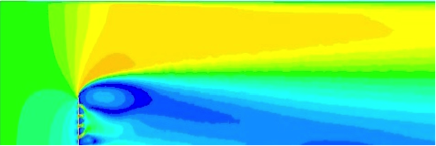
Figure 2: Top: turbulent kinetic energy, Bottom: streamline velocity for RNG-KE.
I really like this place, Ljubljana, especially in summer, with its pleasant environment and location in the center of mountains it’s really nice to work on my project and enjoy a cool summer. The city of Ljubljana is wonderful city with lots of things to do, like hiking, sightseeing and also you have access to the beach. We went to the beach and to old city of Piran and that was one of the most wonderful experiences of my life, as it was my first time on the coast. I really enjoyed it there and also interacted with Slovenian people.
Scientific computing provides a platform for mock experiments for new scientific problems because actual experiments are not easy and also costly for many mega projects like, fusion science, earthquake science, weather forecasting and many more. For these projects, the only option you find without wasting lots of money and time is HPC. In computing, you don’t need only thousands of the computers but rather some very efficient algorithms. In this way parallel programming and HPC are the ways to produce some useful science. At the moment, in Europe, PRACE is at the forefront of computational cooperation and they provide opportunities to researchers. So at my end, HPC can give efficient and well suited solutions to your problems. This experience of HPC will surely help me in understanding my future studies of fusion plasma for energy production.
Author: Allah Rakha
PRACE SoHPC 2014 Student, at Faculty of Mechanical Engineering, University of Ljubljana, Slovenia
Mentor: Dr. Marijo Telenta
marijo.telenta@lecad.fs.uni-lj.si
Faculty of Mechanical Engineering, University of Ljubljana, Slovenia
Coordinator: Dr. Leon Kos
Faculty of Mechanical Engineering, University of Ljubljana, Slovenia
Figure 3: Ljubljana Castle.
The SoHPC Experience
The study is hard to read in the browsers because of equations used, therefore it can also be downloaded here: a2_a_rakha_final.
Numerical Study of the Different Turbulence Models for Wind Barriers
Allah
Rakha
>
Mentor: Dr. Marijo
Telenta
(marijo.telenta@lecad.fs.uni-lj.si) University of
Ljubljana, Faculty of Mechanical Engineering, Slovenia
Coordinator: Dr. Leon Kos
(Leon.kos@lecad.fs.uni-lj.si) University of
Ljubljana, Faculty of Mechanical Engineering, Slovenia
1. Abstract
The flow near and behind the porous
barrier is studied here numerically at a detailed level. The unsteady
Reynolds-averaged Navier-Stokes (URANS) computation is applied here to
investigate and compare two different turbulence models because flow here is
not statistically stationary. The comparison of these two turbulent models
RNG-KE and RKE is done by assessment of turbulent kinetic energies and
velocities. The barrier model comprised of horizontal bars with inclination
angle of ![]() is
is
applied in this study. Our results show that RKE model can simulate for fluid
velocity and turbulent kinetic energy up to higher heights of the barriers. In
addition, the drag force is different by ![]() and
and
![]() for
for
RNG-KE and RKE models respectively.
2. Introduction
There are many turbulence models for
the study of these wind barriers in order to generate shelter for desired
purposes. In this project we are testing three of those theoretical turbulence
models for bar type wind barrier configuration with inclination angle of ![]() . Numerical simulations are performed using the
. Numerical simulations are performed using the
finite volume method based in ANSYS Fluent Computational Fluid Dynamics code.
The models are Realizable ![]() and
and
RNG-KE Model.
The complex flow near and through
the openings of a porous wind barrier is the cutting edge research for various
applications. The flow characteristics of the turbulent wake behind the barrier
are experimentally and numerically investigated. In this study, the wind
barrier is accurately geometrically represented with a three- dimensional model
in the numerical simulation. The unsteady Reynold -averaged Navier Stokes
(URANS) computation is applied since the flow is not statistically stationary.
A deeper understanding of turbulent
structure dynamics is required to evaluate the sheltering effect. Previous
studies used the Reynolds averaging method with turbulence closure for a two-
dimensional fluid flow simulation in which the porous barrier was represented
as a momentum sink. As stated in Bourdin and Wilson (2008), numerical methods
utilizing the momentum sink approach for wind barrier modeling treat complex
unresolved flow near and through the gaps at a superficial level. The goal of
this work is to compare different fluid models and numerically simulate fluid
flow through a geometrically accurate three-dimensional barrier model and
resolve the flow near and through the porous barrier. In particular, the
objective is to investigate the interaction between bleed flow and reverse flow
for different barrier configurations.
3. Barrier Model
Mostly used wind barriers are of two
types, solid and porous. Porous wind barriers are mainly used as turbulence
manipulators and are exploited for many practical applications. There are a
variety of porous barrier constructions, such as upright, horizontal and
screened. Up right and horizontal wind barriers are usually made from bars and
are widely used because their construction is simple and economical. In this
work, the porous bar barrier model is used with inclination angle of ![]() [1].
[1].
4. Fluent
The numerical simulation was set to
represent the scaled wind tunnel experiment. The commercial CFD code Ansys
Fluent 14.5 was used to solve the equations of fluid motion. Ansys Fluent is
general- purpose, proprietary software that is well-known and a standard flow
solver. It uses cell-centered numerics, in this simulation, a segregated
approach, on a collocated, unstructured grid. The three-dimensional finite
volume method was used for RANS equation discretization. The second-order
accurate central discretization for the diffusion terms, the second-order
accurate up wind discretization for the advection terms, and the second order
accurate time discretization were used. The PISO algorithm was applied for
pressure velocity coupling because it is recommended for transient
calculations. Unsteady Reynolds-averaged Navier Stokes (URANS) modeling was
utilized. URANS relies on RANS models but are unsteady even with steady
boundary conditions, and therefore vortex shedding is allowed past a bluff
body. If massive separation is found in the flow, the numerical simulation
cannot find a steady state and the only course is to operate in a time-accurate
mode and analyze an unsteady solution (Spalart, 2000). Proper RANS simulation
must be time – dependent when the flow is periodic in time. Steady computations
produce an erroneously long wake since they omit an important component of the
averaged flow field, the periodic vortex shedding. The unsteady computations
reproduce essential physics of three- dimensional and massively separated flows
(Iaccarino et al., 2003).
4. 1. Parallel Computing
High performance computing (HPC) was
utilized for numerical simulations on a Prelog cluster (2011) with 756
processor cores with 4 GBytes of RAM each. The computer code was parallelized
applying the message passing interface (MPI) technique for communication between
processes. Each numerical simulation was solved on 72 processor cores for a
total duration of 360 hours.
4. 2. Mathematical Model
The fluid was described by
incompressible Navier Stokes equations.
|
|
(1) |
|
|
(2) |
Where ![]() is
is
the i-component of the velocity, ![]() is
is
the i-direction, t is the time, p is the pressure, ![]() is
is
the density and ![]() is
is
the kinematic viscosity. Eq. (1) represents the momentum equations, and Eq. (2)
represents the continuity equation.
4. 3. Meshing
The ICEM-CFD commercial grid
generator software was utilized to create the numerical grid. Tetrahedral grids
were created due to the geometric complexity. Hyperbolic stretching was used to
make a finer grid near the wall boundary condition of the wind tunnel and the
barrier. Strong clustering was applied close to the wall boundary conditions to
capture the near-wall turbulent regions. The stretching ratio between two
adjacent cells was a maximum of 1.08.
4. 4. Boundary Conditions
The dimensions of the computational
domain were set to simulate the wind tunnel and are shown in Fig. 1.
>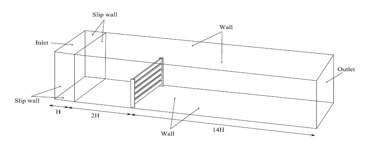
Figure 1.
Extension of the computational domain with boundary conditions [1]
The inlet was placed 3H upstream of
the barrier, and the flow outlet was placed 14H downstream. The tunnel height
was 0.407m.Based on the experiments; solid walls were used to simulate the
barrier’s surface and the floor, roof and lateral walls of the wind tunnel.
No-slip boundary conditions were applied on all these surfaces. Thus, the
appropriate boundary layer and blockage ratio were used in the wind tunnel
cross section. At the domain inflow, the upstream face, a velocity inlet
boundary condition with a uniform velocity profile was specified. A small
turbulence intensity of ![]() was
was
imposed at the inlet and corresponded to the experimental case. A pressure
outlet was applied at the domain outflow.A slip wall boundary condition was
applied on all four sides along a distance H from the inlet boundary condition.
This is done in order to correctly simulate the flow at the leading edge.
5. Convergence Criteria
Computations were calculated until
the maximum continuity residual dropped five orders of magnitude. The barrier
drag was monitored during the iterative numerical procedure. Because the
unsteady RANS (URANS) method was used, the simulation was run until the transient
flow field became statistically steady. Monitoring the integral value, in this
case, the barrier drag, helped determine if this condition was met. The size of
the time step was 3e-05s. The ANSYS Fluent temporal formulation was fully
implicit. Thus, there was no stability criterion that needed to be met in
determining the size of the time step. The choice of the size of the time step
was based on the number of iterations at each time step. The number of
iterations per time step was around the recommended5–10.Furthermore, the
Courant Friedrichs Lewy (CFL) number was monitored. It was kept at CFL![]() .In addition, there were much more than the
.In addition, there were much more than the
suggested 20 time steps per period for vortex shedding.A smaller time step size
did not alter the numerical results.
6. Turbulence Modeling
The governing equations due to the
Reynolds averaging procedure have additional unknown variables, known as
Reynolds stresses. Thus, the governing equations need a turbulence model to be
solved. The turbulence models used in this study are RNG ![]() Model and Realizable
Model and Realizable ![]() .
.
6. 1. RNG  Model
Model
The RNG ![]() model has a similar form to the standard
model has a similar form to the standard ![]() model. The turbulence kinetic energy,
model. The turbulence kinetic energy,![]() and
and
its rate of dissipation, ![]() are
are
obtained from the following transport equations:
![]() (3)
(3)
|
|
(4) |
where, constants are defined as follows,
![]() =
=
Generation of turbulence kinetic energy due to the mean velocity
gradients.
![]() =
=
Generation of turbulence kinetic energy due to buoyancy.
![]() =
=
Contribution of the fluctuating dilatation in compressible turbulence to the
overall dissipation rate.
![]() and
and ![]() =
=
Inverse effective Prandtl numbers for ![]() and
and
![]() , respectively.
, respectively.
![]() and
and ![]() =
=
User-defined source terms.
![]() =
=
Model Constants.
6. 2. Realizable  Model
Model
The realizable ![]() model differs from the standard
model differs from the standard ![]() model in two important ways.
model in two important ways.
1) It has an alternative formulation
for the turbulent viscosity.
2) A modified transport equation for
the dissipation rate ![]() , has been derived from an exact equation for
, has been derived from an exact equation for
the transport of the mean-square vorticity fluctuation.
The term realizable means that the
model satisfies the constraints on Reynolds stresses, consistent with the
physics of turbulent flows.
The modeled transport equations for ![]() and
and
![]() in
in
the realizable ![]() model are,
model are,
|
|
(5) |
and
|
|
(6) |
Where,![]() ,
, ![]() ,
,![]()
Where all these constants are
defined in section![]()
5. Results
The simulation results for these
models for turbulent kinetic energy and velocity are given here for the
comparison. While comparing the stream line velocity for these two models, both
models have three maxima and minima and for turbulent kinetic energy, both
models have two maxima and minima with ranges.
5. 1. Results of RNG  Model
Model
For RNG-KE model Fig. 2 the minima
are at ![]() and
and
![]() with streamline velocity
with streamline velocity ![]() and
and
![]() respectively and maxima are at
respectively and maxima are at ![]() and
and![]() with streamline velocity
with streamline velocity ![]() and
and
![]() respectively. The RKE model Fig. 6 has
respectively. The RKE model Fig. 6 has
minima at ![]() and
and
![]() with streamline velocity
with streamline velocity ![]() and
and
![]() respectively and maxima at
respectively and maxima at ![]() and
and
![]() with streamline velocity
with streamline velocity ![]() and
and
![]() respectively.
respectively.
>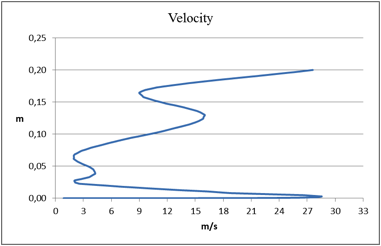
Figure 2.
Velocity profile from the numerical simulations at 1H position
On the other hand from contour
plots, the velocity for RNG-KE model Fig. 3, it is higher at the top and very
low at the lower end of the barrier and behind the porous part, it has medium
values with very low turbulence. On the contrast, for the RKE model Fig. 7, it
has very high values above and very low the barrier and very low values at the
upper edge of the barrier. Behind the porous part of the barrier it has medium
values with nearly zero turbulence.
>
Figure 3.
Contour plot of velocity profile from the numerical simulations
For model (RNG-KE) Fig. 4 the minima
are at ![]() and
and
![]() above the barrier with
above the barrier with ![]() of
of
turbulent kinetic energy. And maxima are at the height of ![]() and
and
![]() with turbulent kineticenergy of the
with turbulent kineticenergy of the ![]() and
and
![]() . For model (RKE) Fig. 8 the minima of turbulent
. For model (RKE) Fig. 8 the minima of turbulent
kinetic energy are ![]() and
and
![]() at
at
the height of ![]() and
and
![]() and
and
maxima are at the ![]() and
and
![]() with turbulent kinetic energy of the
with turbulent kinetic energy of the ![]() and
and![]() .
.
>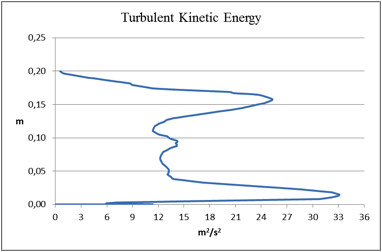
Figure 4.
Turbulent kinetic energy profile from the numerical simulations at 1H position
This model also has a medium value
of the turbulent kinetic energy ![]() which is higher than the RNG-KE model i.e
which is higher than the RNG-KE model i.e
![]() at
at ![]()
>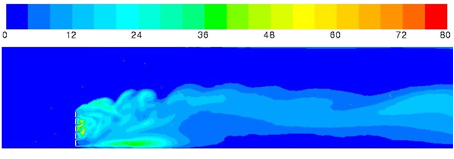
Figure 5.
Contour plot of turbulent kinetic energy profile from the numerical simulations
5. 2. Results of Realizable  Model
Model
These results show that RKE model
has higher values of the turbulent kinetic energy as compared to RNG-KE model
at nearly same heights of barrier. Finally, most important, in RNG-KE Model the
turbulent kinetic energy is zero above 0.20 m of barrier however,
in the RKE model its value is ![]() . This shows that RKE Model simulates results
. This shows that RKE Model simulates results
up to higher heights from barrier.
>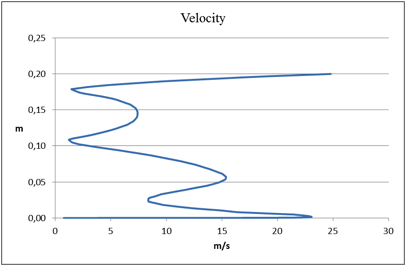
Figure 6.
Velocity profile from the numerical simulations at 1H position
>
Figure 7.
Contour plot of velocity profile from the numerical simulations
From contour plots for RNG-KE model
Fig. 5, the turbulent kinetic energy is higher at both lower and upper end and
behind the porous part of the barrier. The turbulence is less at lower end and
higher at upper edge of the barrier, however the eddies behind porous part of
the barrier give rise to small range of turbulence in order to produce strong
reverse flow. While for RKE model Fig. 9, the turbulent kinetic energy is
higher at the top barrier and turbulent flow is also higher behind the barrier
with short range strong reverse flow.
>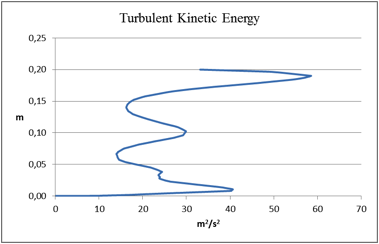
Figure 8.
Turbulent kinetic energy profile from the numerical simulations at 1H position
>
Figure 9.
Contour plot of turbulent kinetic energy profile from the numerical simulations
Finally, the drag force, for the
RNG-KE model we calculate is ![]() and
and
for RKE model is ![]() , while experimental value is
, while experimental value is ![]() . Thus the difference between the RNG-KE model
. Thus the difference between the RNG-KE model
and experimental is ![]() and
and
RKE has ![]() with experimental value.
with experimental value.
6. Acknowledgment
This work was supported by PRACE-3IP
under the grant of SoHPC-2014, program with University of Ljubljana, faculty of
Mechanical Engineering, Slovenia.
7. References
1) Telenta, M., Duhovnik, J., Kosel,
F. Sajn, V., 2014. Numerical and experimental study of
the flow through a geometrically accurate porous wind barrier model. J.
Wind Eng. Ind. Aerodyn. 124, 99-108.
2) Jones, D. A. and Clarke, D.B.,
2005. Simulation of a Wing-Body Junction Experiment using the
Fluent Code. DSTO-TR-1731, DSTO Platforms Sciences
Laboratory, Australia.
3) ANSYS FLUENT Theory Guide.
Release 14, November 2011.
4) Bourdin, P.,Wilson,J.D.,
2008.Wind break aerodynamics: is computational fluid dynamics reliable? Boundary Layer Meteorol.126, 181-208.
5) Iaccarino, G.,Ooi,A.,Durbin,
P.,Behnia,M., 2003. Reynolds averaged simulation of unsteady separated flow. Int.J.Heat Fluid
Flow 24, 147-156.
6) Spalart, P., 2000. Strategies for turbulence modelling and simulations. Int. J.
Heat Fluid Flow
21, 252-263.
